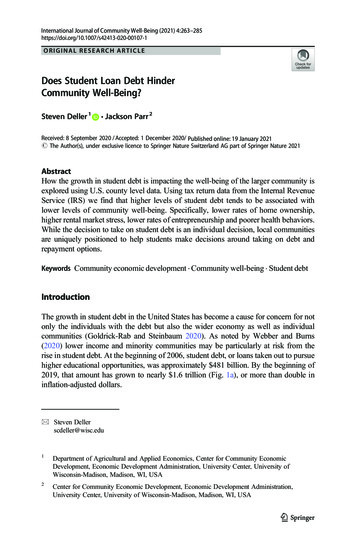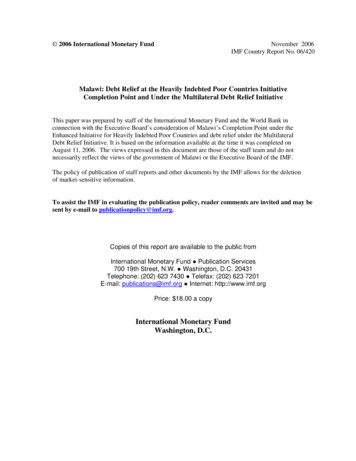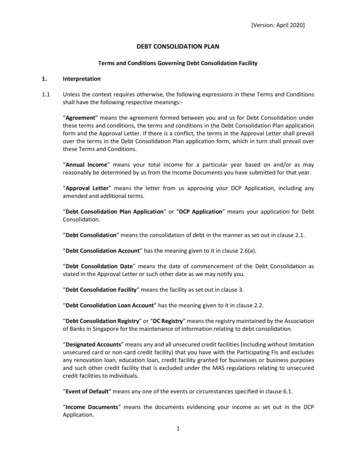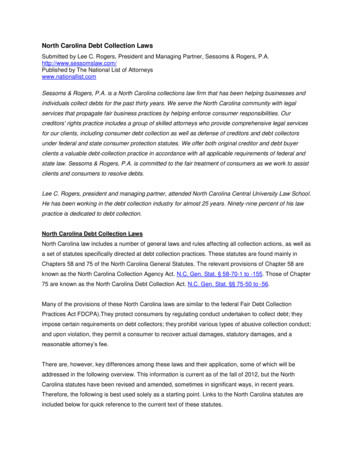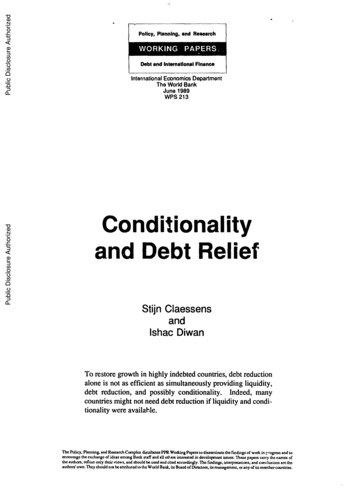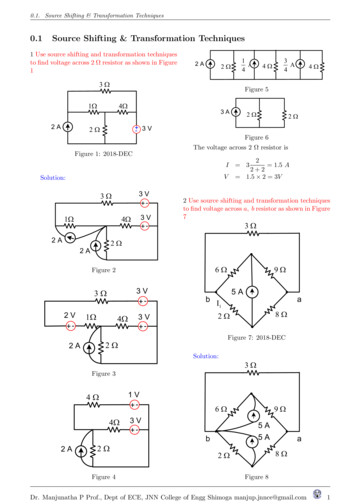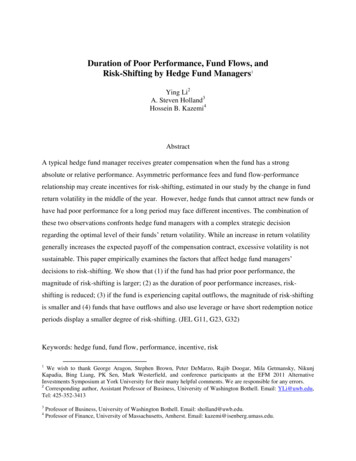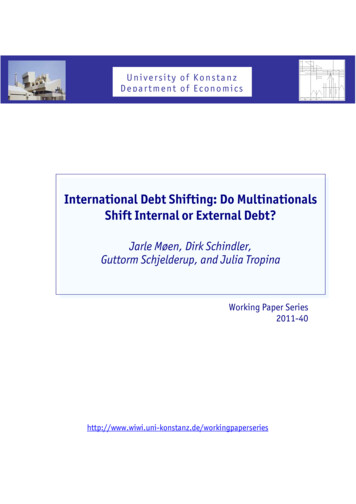
Transcription
University of KonstanzDepartment of EconomicsInternational Debt Shifting: Do MultinationalsShift Internal or External Debt?Jarle Møen, Dirk Schindler,Guttorm Schjelderup, and Julia TropinaWorking Paper ngpaperseries
International Debt Shifting:Do Multinationals Shift Internal or External Debt? Jarle Møen†Dirk Schindler‡Guttorm Schjelderup§Julia Tropina¶October 7th, 2011AbstractWe examine the capital structures of multinational companies. Multinational companies can exploit the tax advantage of debt more aggressively than national companiesby shifting debt from affiliates in low-tax countries to affiliates in high-tax countries.Previous papers have omitted either internal debt or external debt from the analysis.We are the first to model the companies’ choice between internal and external debtshifting, and show that it is optimal to use both types of debt in order to save taxes.Using a large panel of German multinationals, we find strong empirical support for ourmodel. The estimated coefficients suggest that internal and external debt shifting areof about equal relevance.Keywords: Corporate taxation, multinationals, capital structure, internationaldebt-shifting, tax avoidanceJEL classification: H25, G32, F23 We are grateful to Carsten Bienz, Roger Gordon, Heinz Herrmann, Harry Huizinga, Erling Røed Larsen,Tore Leite, Martin Ruf, Georg Wamser, and Alfons Weichenrieder as well as to participants at the annualconference of the Western Economic Association International in Portland, the Norwegian Research Forumon Taxation in Moss, and to participants at seminars in Bergen, Oslo and Tilburg for very helpful suggestions. Special thanks go to the people at Deutsche Bundesbank, in particular to Alexander Lipponer, fortheir invaluable support and for the hospitality of their research center. Remaining errors are ours. Financial support from the Research Council of Norway and the Deutsche Forschungsgemeinschaft is gratefullyappreciated.†Department of Finance and Management Science, Norwegian School of Economics: jarle.moen@nhh.no.‡Department of Economics, Universität Konstanz: dirk.schindler@uni-konstanz.de.§Corresponding author. Department of Finance and Management Science, Norwegian School of Economics, Helleveien 30, N-5045 Bergen, Norway. Email: guttorm.schjelderup@nhh.no.¶Department of Economics, Norwegian School of Economics: julia.tropina@nhh.no.
I.IntroductionIt is well known that the debt tax shield is a key driver of both domestic and multinationalcompanies’ capital structure. Multinational companies, however, can exploit the tax advantage of debt more aggressively than national companies by shifting debt from affiliates inlow-tax countries to affiliates in high-tax countries. The value of this tax arbitrage affectsthe capital structure choice of multinational companies in addition to other costs and benefits of debt previously described in the trade-off theory. Important non-tax factors includethe use of debt as a disciplining device for overspending managers, and the need to balanceindebtedness against the risk of costly bankruptcy.1Several papers have documented that multinational corporations use international debtshifting as a part of their financial strategy, but they disagree on the mechanism. Huizinga etal. (2008) model the optimal allocation of external debt and find that ignoring internationaldebt shifting as part of the firm’s leverage decision understates the impact of national taxeson debt policies by about 25 %. Egger et al. (2010) model debt shifting by the use ofinternal debt and find that multinationals have a significantly higher debt-to-asset ratiothan national firms, and that this difference is larger in high-tax countries.2 Both Huizingaet al. (2008) and Egger et al. (2010) use total debt, i.e., the sum of internal and externaldebt, in their empirical analyses. Because of this, the papers do not provide unambiguousempirical evidence in favor of their respective theory models.In this paper, we use a theory model to derive the tax-efficient capital structure ofaffiliates of multinational corporations. The model embeds all the well-known costs andbenefits of using debt as described in the previous literature, but adds to previous theoryby incorporating debt tax shield effects from both internal and external capital markets. Inparticular, our model shows that there are three debt tax shield effects that multinationalcompanies can use; the standard debt tax shield effect and two effects related to internationaldebt shifting.The first theoretical result to come out of our analysis is that firm value is maximized1The various costs and benefits of debt have recently been reexamined in empirical studies by van Binsbergen et al. (2010) and Korteweg (2010). They estimate that the net benefits of debt amount to 5.5 % offirm value and 3.5 % of a firm’s book value, respectively.2Internal debt is also a topic in, e.g., Mintz and Weichenrieder (2010), Büttner et al. (2009) and in theseminal paper by Desai et al. (2004).2
when multinational companies shift both internal and external debt across internationalborders. Previous studies that omit one of these components, therefore, do not truly portraitprofit-maximizing behavior.The model also predicts that the value of the firm is maximized if internal lending isconducted by a financial center located in the country with the lowest effective rate of tax.As pointed out by Mintz and Smart (2004), this structure assures that interest earned istaxed at the lowest possible tax rate, while interest paid is deducted from taxable income inaffiliates that face a higher tax rate. This reduces the global tax bill.3Recently, Huizinga et al. (2008), have shown that external debt shifting matters whenholding companies explicitly or implicitly guarantee to bail out affiliates facing bankruptcy.In line with their analysis, we find that the value of the external debt shield is maximizedwhen multinational companies balance external debt across affiliates, taking into account thetax rate in all the countries where the group is present. An increase in the tax rate in onecountry will make it profitable to use more debt in the affiliate located in this country. Moredebt will, however, increase the risk of bankruptcy for the group. This effect is mitigatedby lowering the use of debt in all other affiliates. By shifting external debt in this way,multinationals can exploit the debt tax shield to a greater extent than national firms, whilekeeping the overall risk of bankruptcy in check.The use of both internal and external debt is motivated by differences in national statutory tax rates in countries where affiliates are located. This implies that the tax variablesthat determine the incentive to shift internal and external debt are correlated both witheach other and with the host country tax rate. A final prediction that comes out of ourtheoretical analysis is therefore that empirical studies which omit either internal or externaldebt shifting suffer from an omitted variable bias.We put our model to the test using a unique micro-level data set provided by DeutscheBundesbank. The data set contains information on all German multinationals (MNCs) thathave at least one affiliate with more than three million euros in total assets. Contrary toother data sets, it contains information on external debt, and on internal debt from bothparent companies and other affiliates within the group. Furthermore, our data set provides3An example of a company using this strategy is found in the Formula One business, where several highlyinternal-debt loaded firms under the umbrella of the Delta Topco Holding are paying 15 % interest to aninternal bank located on the Channel Island Jersey which is well known as a tax haven. See Sylt and Reid(2011).3
information about the full ownership structure, that is, it allows for indirectly held firmsand potential ownership chains. Our main sample consists of 33,857 firm-year observationsof foreign affiliates of 3,660 German MNCs that form corporate groups that have affiliatesonly in Europe (30 countries). In robustness tests, we also use extended samples, includingup to 105,772 firm-year observations from 68 countries worldwide.Our empirical analysis supports the predictions that follow from the model. Even thoughthe three tax variables in the analysis are highly correlated by construction, we are ableto identify the three tax shield mechanisms separately and with relatively high precision.The economic importance of our estimated coefficients can be illustrated by looking at ahypothetical case where a multinational group consists of two affiliates of equal size. If theaffiliate located in the country with the highest tax rate experiences a 10 percentage pointstax increase, the debt-to-asset ratio will fall by 1.4 percentage points in the low-tax countryand increase by 4.6 percentage points in the high-tax country. For a company with an averagedebt-to-asset ratio at the outset, a 4.6 percentage points increase in the debt-to-asset ratioimplies a 7.4 % increase in debt. About 40 % of the increase in debt is due to the tax inducedadvantage of debt that both national and multinational firms benefit from, while about 60 %is due to international debt shifting. In the case of international debt shifting we find thatthe shifting of internal and external debt are of about equal importance.With respect to omitted variable bias, we find that when the host country tax rate is theonly tax variable in our regression, the estimation bias in the standard tax shield becomesabout 140 % relative to our preferred estimate. This is the specification one would use if nottaking any kind of international debt shifting into account, and it would be sufficient for asample of purely domestic firms.Except for Huizinga et al. (2008), all previous papers neglect external debt shifting. Inthis case, the effect of the standard debt tax shield that both national and multinationalfirms benefit from, is overestimated by 100 % in our sample. The bias in the contributionof internal debt shifting is more modest, but at 40 %, it is still substantial. When internaldebt is neglected in the estimations, as in Huizinga et al. (2008), the omitted variable biasis relatively modest; about 9 % for the standard debt tax shield and about 4 % for externaldebt shifting.We have tested the robustness of our results in a number of ways. Splitting the sampleinto large and small MNCs, we find only minor differences in the tax response between the two4
groups. Allowing for non-linearities in the tax response, we find that our linear specificationis well supported. Extending the sample, utilizing all affiliates of German MNCs in Europe,irrespective of whether the MNC also has affiliates outside Europe, we obtain coefficientsthat are close to those estimated on the original sample, but that are more precise. Moreover,the model performs better in the sense that the coefficients from the external and internaldebt-to-asset ratio regressions are quite close to the corresponding coefficients from the totaldebt-to-asset ratio regressions. Extending the sample further, including MNCs with affiliatesin all 68 countries for which we have complete tax and macro data, we obtain results thatare qualitatively the same as in the original sample, but with the external debt shiftingmechanism and internal debt mechanisms being less pronounced. We speculate that thedata quality is better for European countries, and that concerns other than those we modelmay play a larger role for investment decisions outside Europe.We also check robustness with respect to adjusting the tax variables to preferential taxregimes for financial service affiliates in the BeNeLux countries and Switzerland. This leadsto a decrease in size for the weighted and maximum tax difference coefficients. When wemake a further adjustment to allow for German CFC rules, the coefficient for the internaldebt mechanism is lower than in the original regression, but higher than in the regressionwhere only preferential tax regimes were controlled for. The coefficients for the two othertax variables become considerably smaller. These results may partly reflect that our adjustment procedure, based on country and industry classification, is too rough, and partly thatthe German CFC rules are effective in restricting the possibility to exploit preferential taxregimes as concluded by Ruf and Weichenrieder (2009) and Egger and Wamser (2011).The remainder of this paper is organized as follows: The next section presents related literature. Section III outlines the model. Section IV presents data, definitions and descriptivestatistics. Section V discusses our identification strategy. Section VI contains our empiricalresults. Section VII explores the robustness of our results with respect to various sampleand specification choices while section VIII concludes the paper.5
II.Related literatureEarly studies on firms’ capital structure found no or very weak effects of tax incentives onthe use of debt.4 One reason for this may be the lack of variation in corporate tax rates inthe time period these studies span (see Auerbach, 2002; and Graham, 2003). In the early tomid 1980s, however, most OECD countries liberalized their foreign exchange rules, therebymaking capital fully mobile internationally. In the wake of this, most OECD countriesreformed their tax systems. The most prominent change was a substantial reduction instatutory corporate tax rates combined with a broadening of the tax base (see Devereux etal., 2002).For multinationals, the tax sensitivity of debt has recently been established in a string ofpapers. Desai et al. (2004) analyze the capital structure of multinational corporations, usingdata from 3,900 U.S. multinationals and their foreign affiliates. The data set distinguishesborrowing from external sources and borrowing from parent companies, but does not allowthem to take into account internal capital market transactions between affiliates. They findthat a 10 % rise in local tax rates leads to a 2.8 % higher affiliate debt as a fraction ofassets. Furthermore, the estimated elasticity of external borrowing with respect to the taxrate is 0.19, whilst the tax elasticity of borrowing from parent companies is 0.35. Theirstudy thus shows that internal debt is more tax sensitive than external debt, and they alsofind that affiliates in countries with weak creditor rights and shallow capital markets tend toborrow more from their parent companies than from external sources. Since their data donot include internal capital market transactions between affiliates, Desai et al. (2004) cannotstudy internal lending from affiliates of multinationals that serve as financial coordinationcenters performing banking services for the multinational firm. Such centers are widely usedamong some of the world’s largest multinational firms and are located in countries withspecial tax provisions for such activities (e.g., Belgium). Consequently, it is likely that theirresults underestimate the tax sensitivity of internal debt, all else equal. This would workagainst a bias from omitting international shifting of external debt.Mintz and Smart (2004) study corporate taxation when firms operate in multiple jurisdictions and shift income using tax planning strategies. Their model predicts that a4A notable exception is Mackie-Mason (1990) who avoids the lack of tax rate variation by focusing onwhether a firm is near tax exhaustion.6
multinational firm should use internal debt so that its borrowing occurs in high-tax jurisdictions and declare all interest income in the affiliate located in the jurisdiction with the lowesteffective tax rate. This way, the firm maximizes the value of the tax-deductible interest andminimizes the tax paid on interest income within the group. Their model also yields theresults that income shifting affects real investments, government tax revenue, and tax baseelasticities. The model is tested on Canadian data. Using their preferred estimate, the elasticity of taxable income with respect to tax rates for income shifting firms is 4.9, while forother comparable firms it is 2.3. Büttner and Wamser (2009) study borrowing and lendingwithin German multinational companies. They find - just like Mintz and Smart (2004) that tax differences within the multinational group have a robust impact on internal debt.They find, however, that the estimated effect is rather small.In the spirit of Mintz and Smart (2004), Egger et al. (2010) set up a model wheredomestic firms endogenously can choose to become a multinational firm and allocate debtbetween affiliates in order to save tax payments. They test their predictions on a sampleof 32,067 observations of multinational and national firms in 27 European countries. Theyfind that foreign-owned firms on average exhibit a significantly higher debt ratio than theirdomestically owned counterparts in the host country, and that the debt-to-asset ratios ofaffiliates of multinationals are more tax sensitive than those of domestic firms. The dataused by Egger et al. (2010) do not hold information on internal debt at the firm level, nordo their data show the full ownership structure of multinational firms. Furthermore, theiranalysis does not include overall bankruptcy cost on the parent level and also omits thepossibility that external debt can be allocated across affiliates to save tax.Our study is most closely related to Huizinga et al. (2008) who study how differencesin national tax systems affect the use of external debt. They assume that the parent firmprovides explicit and implicit credit guarantees for the debts of all of its affiliates, and thata higher total debt-to-asset ratio for the group increases the risk of bankruptcy. This leadsthem to predict that multinational firms will balance external debt across affiliates by takinginto account the tax rate in all the countries where they are present. An increase in the taxrate in one country will make it profitable to use more debt in the affiliate located in thiscountry. More debt will, however, increase the risk of bankruptcy for the group. This effectis mitigated by lowering the use of debt in all the other affiliates. By shifting external debtthis way, multinationals can exploit the debt tax shield more aggressively than national firms7
while keeping the overall risk of bankruptcy in check.Huizinga et al. (2008) test their model on firm data from 32 European countries in theAmadeus data base covering the years 1994 to 2003. Their empirical investigation showsthat tax changes do indeed lead to a rebalancing of debt. For a multinational firm withaffiliates of equal size in two countries, a 10 % overall tax increase in one country increasesthe debt-to-asset ratio in that country by 2.4 %, whilst the debt-to-asset ratio in the othercountry falls by 0.6 %. These results are, however, based on variation in total debt, asexternal debt cannot be isolated in the Amadeus database. It is therefore possible that theuse of internal debt in multinational firms confounds the analysis.5 Our model takes thestudy of Huizinga et al. one step further by allowing for internal debt shifting. Moreover, wetest our model on data that contain information on both internal and external debt. Thatway we can establish that separate regressions for internal and external debt-to-asset ratiosyield results that are consistent. In particular, we check whether tax variables that accordingto our model are irrelevant in these equations have significant explanatory power.III.The ModelA multinational company is domiciled in country p, but has fully owned affiliates in i 1, ., n countries. Without loss of generality we assume that the parent is a pure holdingcompany and that all affiliates are directly owned by the MNC, i.e., there are no ownershipchains. Each affiliate has fixed assets Ki and for the purpose of exposition we let this assetbe capital used to produce a homogenous good by the production function yi f (Ki ).Rental costs of capital are exogenous (small country assumption) and equal to r. CapitalKi is financed either by equity Ei , external (third party) debt DiE , or internal debt DiI fromrelated affiliates. The balance sheet of affiliate i can be stated as Ki Ei DiE DiI , andPthe balance sheet of the MNC is i6 p Ei Ep DpE DpI . The MNC provides each affiliatei with the equity necessary to reach both a tax-efficient financing structure and the optimallevel of real capital.5It should be noted that Huizinga et al. (2008) discuss internal debt in an extension to the empiricalanalysis. In order to explore the robustness of their results, they utilize the tax rate differential between theparent firm and an affiliate. They do not find a significant effect of this variable and conclude that theirmain result is not affected by the incentive to use internal debt. As will become clear in the next section, itis the tax rate differential to the lowest taxed affiliate that is best suited as a variable to measure the use ofinternal debt.8
The use of external and internal debt leads to different types of benefits and costs foran affiliate.6 Although internal debt holds many of the same properties as equity, it is,in contrast to equity, tax deductible.7 However, the use of internal debt is costly due tovarious tax engineering expenses incurred in order to avoid or relax regulations such as thincapitalization rules and/or controlled-foreign-company (CFC) rules.8 We adopt the commonassumption that the cost functions of external and internal debt are (additively) separable,convex in the debt-to-asset ratios, and proportional in capital employed.9 Thus, we canexpress the cost function of internal debt asC I (bIi ) where bIi constant.DiIKiη· (bIi )2 · Ki ,2if bIi 0,and C I (bIi ) 0,if bIi 0,(1)represents the internal debt-to-asset ratio in affiliate i, and η is a positiveExternal debt can be beneficial in reducing informational asymmetries between managersand shareholders and in enforcing discipline on overspending managers (see Jensen andMeckling, 1976; Jensen, 1986). However, too much external debt may induce a debt-overhangproblem that causes local managers to miss good investment opportunities (Myers, 1977). Aspointed out by Kraus and Litzenberger (1973), the preferences given to debt may also lead toexcessive borrowing and higher risk of bankruptcy.10 The costs and benefits of using externaldebt mean that there is an optimal external debt-to-asset ratio in absence of taxation, whichwe define as b in each affiliate. The cost function for external debt is written asC E (bEi ) 2µµ ¡ E· bi b · Ki · (b )2 · Ki ,22where µ is a positive constant, bEi DiEKi(2)represents the external debt-to-asset ratio in affiliate6See Hovakimian et al. (2004) and Aggarwal and Kyaw (2010) for recent overviews on factors affectingthe optimal capital structure.7See Gertner et al. (1994) for a discussion on internal debt and how it relates to external debt and equity.Chowdhry and Coval (1998, pp. 87f) and Stonehill and Stitzel (1969) argue that internal debt should in factbe seen as tax-favored equity.8For a more detailed discussion, see Mintz and Smart (2004) and Fuest and Hemmelgarn (2005).9See, e.g., Fuest and Hemmelgarn (2005) and Huizinga et al. (2008) for similar approaches.10The ‘trade-off’ theory of capital structures balances bankruptcy costs with returns from the tax shield.See, for instance, Graham (2000), who estimates a tax shield value (before personal taxes) close to 10 % ofthe value of the firm.9
i, and the cost function is scaled to be zero when bEi is zero.The use of external debt entails costs to the MNC related to the risk of bankruptcy.The link between external debt shifting and such bankruptcy costs at the holding level wasfirst analyzed by Huizinga et al. (2008) who assume that MNCs are willing to bail out anyaffiliate facing bankruptcy.11 We let Cf be the overall bankruptcy cost at the parentPlevelDEof the MNC. It depends on the firm-wide external debt-to-asset ratio defined as bf Pi Kii .iWe also follow Huizinga et al. (2008, p. 94) and assume that overall bankruptcy costs are aconvex function of the firm-wide debt-to-asset ratio, and proportional to the MNC’s overallassets. The overall bankruptcy cost is specified at the holding level as followsXγγCf · b2f ·Ki ·22i¡P E 2DPi i ,i Ki(3)where γ is a positive constant.True and taxable profit in affiliate i, πie and πit , is defined asI Iπie f (Ki ) r · Ki C E (bEi ) C (bi ),πit f (Ki ) r · (DiE DiI ).We assume that the rental costs of equity are not tax deductible as this is the case inmost real-world tax systems. Moreover, neither the cost of external nor the cost of internaldebt is deductible from the corporate tax base. This is a strong assumption which impliesthat not all the costs related to the debt-to-asset ratio show up on the income statementfor corporate taxation.12 However, this assumption is necessary for deriving well-definedstructural equations for the empirical investigation and is used in, e.g., Huizinga et al.(2008).We let ViL and ViU be the values of an affiliate with and without debt-financing respectively in country i, and define ti as the statutory corporate tax rate in country i. Affiliate11Gopalan et al. (2007) find that business groups do in fact support financially weaker firms in the groupin order to avoid default. They also find that bankruptcy by a group firm gives negative spillovers to otheraffiliates in the form of a significant drop in external financing, investments and profits, and an increase inthe bankruptcy probability.12Note, however, that this assumption does not imply that the costs of debt do not reduce potentialwithholding and repatriation taxes.10
i’s profit after corporate taxation in country i is thenπi πie ti · πit {z } ViLI I (1 ti ) · f (Ki ) r · Ki ti · r · (DiE DiI ) C E (bEi ) C (bi ), {z}(4) ViUI Iwhere it is seen from (4) that affiliate specific debt costs, C E (bEi ) C (bi ), reduce potentialdividend payouts.¡ In a static one-period model such as this, the value of an MNC V L and the MNC’s aftertax profit (Πp ) are identical and can be calculated by summing up profits across all affiliates.Repatriated dividends πi can, in principle, be subject to a non-resident withholding tax,a parent tax rate on repatriated dividends (possibly adjusted for various credit schemes),and the corporate tax rate ti . However, in the empirical section, we focus on Europeancountries, where the exemption method is in place, and where withholding taxes do notmatter. Accordingly, we will neglect these issues.The value of the holding (MNC) can now be written asΠp V L XViL Cf iXπi Cf .(5)iMaximizing Πp , taking into account that the overall sum of lending and borrowing fromPrelated companies must be equal to zero ( i r · DiI 0) and applying equations (1) to (4),the maximization problem can be stated as13max ΠpDiE ,DiI Xn(1 ti ) · f (Ki ) r · Ki ti · r · (DiE DiI )iµ E¶2µ I ¶2o γ ¡P DE 2µDiµηDi 2· b· Ki · (b ) · Ki ·· Ki · Pi i 2Ki22Ki2i KiXIs.t.r · Di 0,i13It can be shown that from the viewpoint of a shareholder in an MNC, maximizing profits of the MNCafter global corporate taxation and maximizing the net pay-off on equity investment after opportunity costsand personal (income) taxes, yield identical results under mild assumptions.11
The resulting first order conditions areP E¶DDiE : ti · r µ · b γ Pi i 0,Kii KiIDDiI : ti · r η · i m · r 0,KiµDiE(6)(7)where m is the Lagrangian multiplier. This gives the shadow price of shifted interest expenses. In optimum, we have m mini ti . It therefore follows that in order to maximizethe internal debt tax shield, the MNC should let the affiliate with the lowest effective taxrate conduct internal lending. For illustrative purposes we number the countries such thatcountry 1 has the lowest tax rate, i.e., mini ti t1 .Examining the condition for internal debt in equation (7), we derive the optimal debtto-asset ratio in internal debt bIi asbIi rr· (ti m) · (ti t1 ) 0, i 1.ηη(8)¡ The internal debt-to-asset ratio in the financial coordination center bI1 is zero, since it is notoptimal for this affiliate to hold any internal debt. The amount of lending (L1 ) conductedby the financial coordination center, is given byL1 XDiI .(9)i 1We see from these two conditions that it is profit maximizing for an MNC to use internaldebt, and that any analysis that omits internal debt does not model a tax-efficient financingstructure.An important implication of equation (7) is that any affiliate can provide internal debt,not only the parent firm. Furthermore, a tax efficient financing structure implies that it isthe affiliate located in the country with the lowest effective tax rate that will be the financialcoordination center (or the internal bank; we use these terms interchangeably).14 This point14Indeed, this seems to explain why countries such as Belgium, Luxembourg and the Netherlands attractso many financial coordination centers of MNCs (see, e.g., Ruf and Weichenrieder, 2009, Table 4). All thesecountries have special tax rules for financial operations that lead to very low effective tax rates. The absenceof source taxes on dividends between EU member states then makes it easy to shift income streams tax free12
was first brought forward in Mintz and Smart (2004) who refer to the location of the financialcoordination center as a tax haven and to the variable (ti t1 ) as a net tax advantage. Werefer to this variable as the maximum tax difference in the empirical part of the paper.Turning to the optimal external debt-to-asset ratio, bEi , we obtain by rearranging equation (6)X β β·t β·ρj (ti tj ),(10)bE01i2ij6 iwhere details are gi
debt-to-asset ratio at the outset, a 4.6 percentage points increase in the debt-to-asset ratio implies a 7.4 % increase in debt. About 40 % of the increase in debt is due to the tax induced advantage of debt that both national and multinational flrms beneflt from, while about 60 % is due to international debt shifting.
